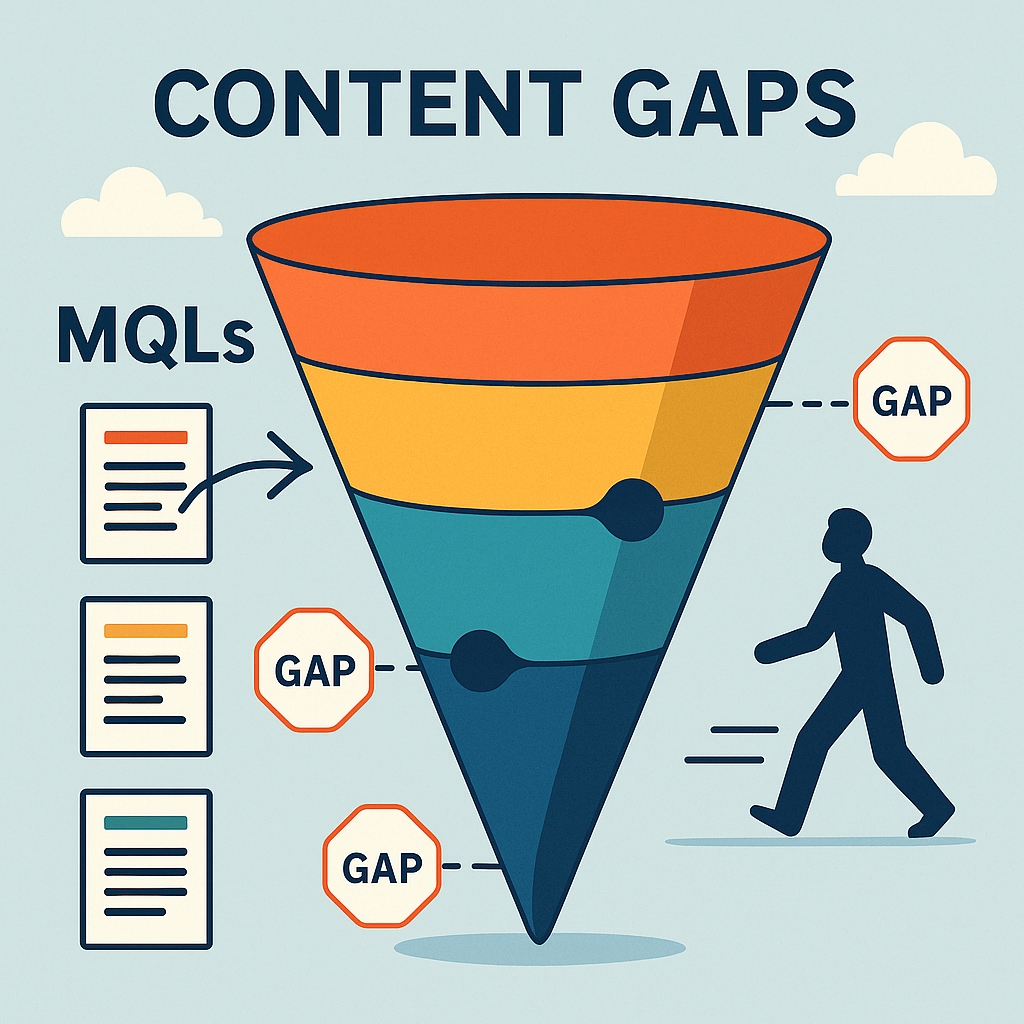Picture this: your marketing qualified leads (MQLs) are flowing in nicely, but somewhere between initial interest and purchase decision, prospects are vanishing like morning mist. Sound familiar? You’re likely dealing with content gaps – those invisible holes in your funnel that quietly sabotage your conversion rates.
Content gaps aren’t just missing blog posts or neglected landing pages. They’re strategic blind spots where your audience needs guidance, reassurance, or information, but finds silence instead. For B2B content marketers and demand generation managers, identifying and fixing these gaps can be the difference between a high-performing funnel and one that hemorrhages potential customers.
Let’s dive into how you can systematically uncover these gaps and transform them into conversion opportunities.

Understanding Content Gaps in the B2B Context
Content gaps in B2B funnels are more nuanced than their B2C counterparts. Your prospects aren’t making impulse purchases – they’re navigating complex buying committees, lengthy evaluation periods, and substantial budget considerations. This complexity creates multiple opportunities for content gaps to emerge.
Think of your funnel as a bridge connecting problem awareness to purchase decision. Content gaps are like missing planks in that bridge. Some prospects might leap across small gaps, but most will turn back or seek alternative routes (read: your competitors).
The most dangerous gaps often occur at transition points: when prospects move from awareness to consideration, or from consideration to decision. These moments require specific types of content that address shifting concerns and information needs.
The Real Cost of Content Gaps
Before we get into identification strategies, let’s be clear about what’s at stake. Content gaps don’t just reduce conversion rates – they multiply your customer acquisition costs while extending sales cycles. When prospects can’t find the information they need at critical moments, they either bounce to competitors or remain stuck in limbo, requiring additional touchpoints and resources to move forward.
For content agencies working with B2B clients, unaddressed content gaps can severely impact campaign performance and client satisfaction. They’re often the hidden culprit behind underperforming campaigns that look good on paper but fail to deliver results.
Strategic Funnel Analysis: Your Foundation
Effective content gap identification starts with comprehensive funnel analysis. This isn’t about vanity metrics – it’s about understanding behavior patterns and decision-making triggers throughout your buyer’s journey.
Begin by mapping your current funnel stages with brutal honesty. Most B2B funnels include awareness, interest, consideration, intent, evaluation, and purchase stages, but your specific industry or product might require additional or different stages.
For each stage, document the primary questions prospects ask, the concerns they raise, and the information they seek. This isn’t guesswork – it should be based on actual data from sales conversations, customer interviews, and user behavior analytics.
Next, audit your existing content against each stage. Don’t just list what content exists; evaluate whether it truly addresses the core needs and concerns at each funnel stage. You might discover that you have plenty of awareness-stage content but lack the specific comparison guides and ROI calculators needed at the evaluation stage.
Pay special attention to transition points between stages. These moments often reveal the most significant gaps because they require content that bridges different mindsets and information needs.
Identifying Content Gaps: A Multi-Method Approach
Sales Team Intelligence
Your sales team interacts with prospects at various funnel stages daily. They hear objections, answer questions, and observe where prospects get stuck. Regular sales-marketing alignment meetings should include specific discussions about content needs.
Ask your sales team: What questions do prospects ask repeatedly? What concerns come up during demos? What information do they wish they had when prospects go dark? What content would make their conversations more effective?
Document these insights systematically. Create a simple framework for capturing and categorizing feedback, ensuring nothing falls through the cracks.
Customer Journey Mapping
Go beyond basic buyer personas to create detailed journey maps that reveal emotional and informational needs at each stage. This exercise often uncovers gaps that aren’t immediately obvious.
Focus on the moments of doubt, confusion, or hesitation in your customer’s journey. These emotional inflection points are where content gaps often hide. Your prospects might need reassurance about implementation challenges, clarity about pricing models, or validation that others in their industry have succeeded with your solution.
Analytics Deep Dive
Your website analytics tell a story about where content gaps exist. Look for pages with high bounce rates, especially those that should naturally lead to next steps. Examine the paths that converting users take versus those who don’t convert.
Heat mapping tools can reveal where users scroll, click, and abandon pages. If users are scrolling extensively but not engaging with calls-to-action, you might have a content depth or relevance gap.
Search query analysis from your internal site search can be incredibly revealing. What are people looking for that they can’t find? These searches often point directly to content gaps.
Competitive Analysis
Your competitors’ content strategies can illuminate gaps in your own approach. But don’t just catalog what they’re doing – analyze why they’re creating specific content pieces and whether those topics represent opportunities you’re missing.
Look at the questions they’re answering in their content, the formats they’re using, and the funnel stages they’re targeting. Sometimes competitors reveal audience needs you hadn’t considered.
Direct Customer Feedback
Don’t underestimate the power of simply asking your customers and prospects what information they wish they had during their buying journey. Post-purchase surveys, customer advisory boards, and lost deal analyses can provide direct insight into content gaps.
Frame questions around their information needs rather than your content. Ask about moments of uncertainty, required internal research, or information gaps that slowed their decision-making process.
B2B Content Optimization: Fixing the Gaps
Once you’ve identified content gaps, the next challenge is prioritizing and addressing them strategically. Not all gaps are created equal, and your resources are finite.
Prioritization Framework
Create a simple scoring system based on three factors: impact on conversion rates, ease of creation, and strategic importance to your business goals. Gaps that affect high-value prospects at critical decision points should take priority over nice-to-have content for early-stage browsers.
Consider the buying committee dynamics in B2B sales. A single purchase decision might involve technical evaluators, financial decision-makers, and end users. Each group needs different information, creating multiple potential gaps for a single opportunity.
Content Format Optimization
The format of your gap-filling content matters as much as the topic. Different funnel stages and buyer personas prefer different content formats. Technical evaluators might need detailed specification sheets, while executives prefer summary dashboards and ROI calculators.
Consider creating content clusters around important topics rather than single pieces. A comprehensive approach might include a detailed guide, a summary infographic, a webinar, and a checklist – all addressing the same core topic but serving different consumption preferences and contexts.
Implementation Strategy
Roll out gap-filling content systematically rather than trying to address everything at once. Start with the highest-impact gaps and measure results before moving to the next priority.
Create feedback loops to ensure your new content actually addresses the identified gaps. Monitor engagement metrics, but more importantly, track whether the content reduces time-to-conversion and improves progression between funnel stages.
Measuring Success and Continuous Improvement
Fixing content gaps isn’t a one-time project – it’s an ongoing optimization process. Establish metrics that matter: funnel progression rates, time spent in each stage, and conversion improvements.
Create a regular review process that combines quantitative analytics with qualitative feedback. Monthly gap analysis reviews can help you stay ahead of evolving customer needs and market conditions.
Remember that as your product evolves and your market matures, new content gaps will emerge. The buyers of today might have different information needs than those from six months ago.
Building a Gap-Aware Content Culture
The most successful B2B content teams develop a cultural awareness of content gaps. This means training your team to recognize potential gaps during content planning, encouraging cross-functional collaboration for gap identification, and creating processes that make gap analysis a natural part of content strategy development.
Consider appointing a team member as a “gap advocate” – someone specifically responsible for identifying and flagging potential content gaps during strategy sessions and content audits.
Moving Forward with Confidence
Content gaps are inevitable in complex B2B funnels, but they don’t have to be permanent roadblocks. By developing systematic approaches to gap identification and creating processes for ongoing optimization, you can transform these challenges into competitive advantages.
The key is treating funnel analysis and gap identification as core competencies rather than periodic tasks. When you make this shift, you’ll find that your content becomes more strategic, your conversion rates improve, and your sales team becomes your biggest content marketing advocate.
Start with one funnel stage, identify the biggest gap, and create content to address it. Measure the impact, learn from the results, and then move to the next gap. This systematic approach might seem slower than trying to fix everything at once, but it builds sustainable processes and delivers measurable results.
Your prospects are counting on you to provide the information they need when they need it. By mastering content gap identification and resolution, you’re not just improving your funnel performance – you’re serving your audience better and building stronger relationships that extend far beyond the initial sale.
